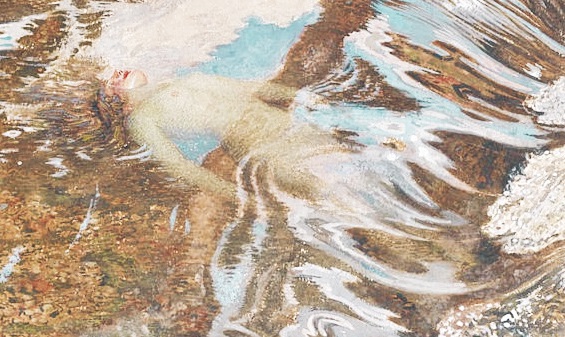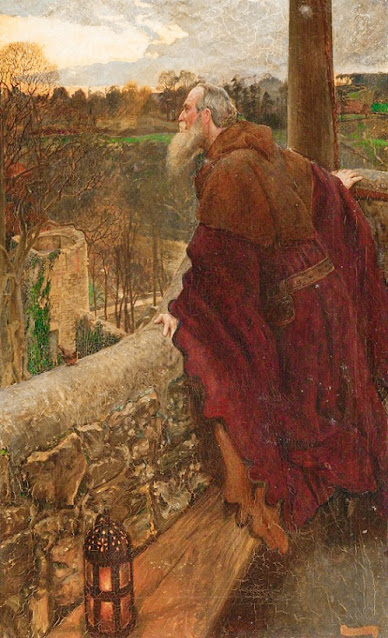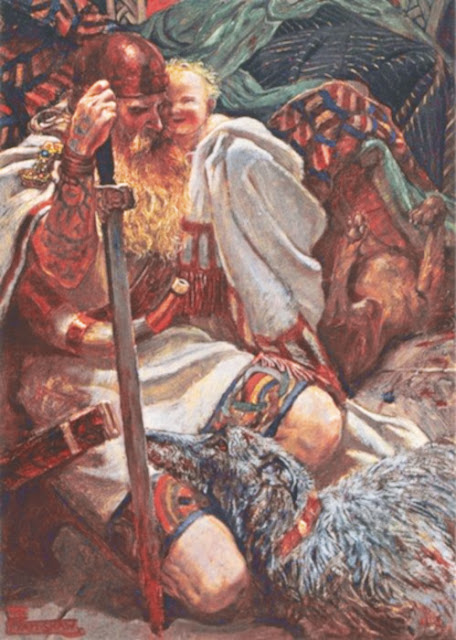Byam Shaw (1872–1919)
Love the Conqueror Oil on canvas
I have no further description, at this time
John Byam Liston Shaw (13 November 1872 – 26 January 1919), commonly known as Byam Shaw, was a British painter, illustrator, designer and teacher.
Byam Shaw (1872–1919)
Omphale, c. 1914
Watercolor and bodycolor
Height: 72.5 cm (28.5 in); Width: 29 cm (11.4 in)
Private collection
Dressed in skin of Nemean lion and holding Hercules' club; the labors of Hercules are in the background
In Greek mythology, Omphale was queen of the kingdom of Lydia in Asia Minor. In her best-known myth, she is the mistress of the hero Heracles during a year of required servitude, a scenario that offered writers and artists opportunities to explore sexual roles and erotic themes. More on Omphale
John Liston Byam Shaw, British 1872 - 1919
Diana of the Hunt
Oil on canvas
I have no further description, at this time
In Roman mythology, Diana was the goddess of the hunt, the moon and nature being associated with wild animals and woodland, and having the power to talk to and control animals. She was eventually equated with the Greek goddess Artemis, though she had an independent origin in Italy. Diana was worshipped in ancient Roman religion and is revered in Roman Neopaganism and Stregheria. Diana was known to be the virgin goddess of childbirth and women. She was one of the three maiden goddesses — along with Minerva and Vesta — who swore never to marry. More on Diane
John Byam Shaw
Goblin Market, c. 1899
Oil on panel
29 x 24 cm.
Private collection
Goblin Market (composed in April 1859 and published in 1862) is a narrative poem by Christina Rossetti. The poem tells the story of Laura and Lizzie who are tempted with fruit by goblin merchants. In a letter to her publisher, Rossetti claimed that the poem, which is interpreted frequently as having features of remarkably sexual imagery, was not meant for children. However, in public Rossetti often stated that the poem was intended for children, and went on to write many children's poems. When the poem appeared in her first volume of poetry, Goblin Market and Other Poems, it was illustrated by her brother, the Pre-Raphaelite Brotherhood artist Dante Gabriel Rossetti. More on Goblin Market

John Byam Shaw
THE LURE
Oil on panel
23 3/4 by 26 1/8 in.60.3 by 66.4 cm
Private collection
Kneeling at the tomb of her deceased husband, a grieving young widow is suddenly interrupted by the impish figure of Love, who mischievously beckons her away from her wifely duty to follow him. While the exact source of the scene is unknown, John Liston Byam Shaw sought artistic inspiration in literature and history and often painted compositions with a clear narrative or underlying moral. More on this painting
John Byam Liston Shaw, 1872-1919
A Dirge
And All Winds Go Sighing
Oil on canvas
1872 x 1919 cms | 737 x 755 1/2 ins
Private collection

JOHN BYAM LISTON SHAW (BRITISH, 1872-1919)
Ophelia
Watercolour heightened with bodycolour
30 x 25cm (11 13/16 x 9 13/16in)
Private collection
Ophelia is a character in William Shakespeare's drama Hamlet. She is a young noblewoman of Denmark, the daughter of Polonius, sister of Laertes and potential wife of Prince Hamlet, who, due to Hamlet's actions, ends up in a state of madness that ultimately leads to her drowning. More on Ophelia
JOHN BYAM LISTON SHAW (BRITISH, 1872-1919)
Detail; Ophelia
Watercolour heightened with bodycolour
30 x 25cm (11 13/16 x 9 13/16in)
Private collection
Byam Shaw (1872–1919)
The Arrested Spear, c. 1916
Oil on Canvas
157.50 cm x 183.00 cm
City Art Gallery, Vancouver
Byam Shaw's most important painting unconnected with the War consisted of his large picture in the Academy of 1916, The Arrested Spear from a scene in Parsifal. It was purchased after his death by the late Lord Leverhulme and presented by him to the City Art Gallery, Vancouver.
Parsifal, hero of Richard Wagner’s opera of the same name, was a knight of the Arthurian Legend, finder of the Holy Grail. The scene portrays Parsifal standing in the garden of the evil magician Klingsor. The Flower Maidens lie at his feet, rejected by his indifference to their temptations. He seizes and holds suspended in mid-air the Sacred Spear, which Klingsor has hurled at him. As Parsifal makes the sign of the cross, Klingsor’s domain falls in ruins. More on this painting
Throughout his career Byam Shaw worked competently in a wide variety of media including oils, watercolour, pastels, pen and ink and deployed techniques such as dyeing and gilding. He was influenced by the Pre-Raphaelites and took many of his subjects from the poems of Rossetti. He exhibited frequently at Dowdeswell and Dowdeswell's gallery in New Bond Street, where he had at least five solo exhibitions between 1896 and 1916.
John Byam Liston Shaw, 1872-1919
The Angel Before Adam
Oil on panel
45.7 x 34.3 cms | 17 3/4 x 13 1/2 ins
Private collection
The Angel offering the fruits of the Garden of Eden to Adam and Eve
Byam Shaw (1872–1919)
The Woman, the Man and the Serpent, c. 1911
Oil on canvas
Height: 182.3 cm (71.7 in); Width: 54.1 cm (21.2 in)
Private collection
Adam and Eve, according to the creation myth of the Abrahamic religions, were the first man and woman and the ancestors of all humans. The story of Adam and Eve is central to the belief that YHWH created human beings to live in a paradise on earth, although they fell away from that state and formed the present world full of suffering and injustice. It provides the basis for the belief that humanity is in essence a single family, with everyone descended from a single pair of original ancestors. It also provides much of the scriptural basis for the doctrines of the fall of man and original Sin, important beliefs in Christianity, although not generally shared by Judaism or Islam. More on Adam and Eve
John Byam Liston Shaw (1872–1919)
The Prodigal's Return
Oil on canvas
H 89.5 x W 64 cm
Russell-Cotes Art Gallery & Museum
The Parable of the Prodigal Son is one of the parables of Jesus Christ, which he shares it with his disciples, the Pharisees and others.
In the story, a father has two sons. The younger son asks for his inheritance and after wasting his fortune, becomes destitute. He returns home with the intention of begging his father to be made one of his hired servants, expecting his relationship with his father is likely severed. The father welcomes him back and celebrates his return. The older son refuses to participate. The father reminds the older son that one day he will inherit everything. But, they should still celebrate the return of the younger son because he was lost and is now found. More on the prodigal son

John Byam Liston Shaw, 1872-1919
The Judgement of Solomon
'And who knoweth whether he shall be a wise man or a fool? Yet shall he have rule over all my labour wherein I have laboured, and wherein I have showed myself wise.'
Oil on panel
40 x 25.1 cms | 15 1/2 x 9 3/4 ins
Private collection
The Judgement of Solomon is a story from the Hebrew Bible in which Solomon ruled between two women both claiming to be the mother of a child. Solomon revealed their true feelings and relationship to the child by suggesting the baby be cut in two, each woman to receive half. With this strategy, he was able to discern the non-mother as the woman who entirely approved of this proposal, while the actual mother begged that the sword might be sheathed and the child committed to the care of her rival. Some consider this approach to justice an archetypal example of an impartial judge displaying wisdom in making a ruling. More on The Judgement of Solomon

John Byam Liston Shaw (1872–1919)
Jezebel, c. 1896
Oil on canvas
H 148.5 x W 81 cm
Russell-Cotes Art Gallery & Museum
Jezebel (fl. 9th century BCE) was a queen, identified in the Book of Kings as the daughter of Ithobaal I of Sidon and the wife of Ahab, King of Israel.
According to the Hebrew Bible, Jezebel incited her husband King Ahab to abandon the worship of Yahweh and encourage worship of the deities Baal and Asherah instead. Jezebel persecuted the prophets of Yahweh, and fabricated evidence of blasphemy against an innocent landowner who refused to sell his property to King Ahab, causing the landowner to be put to death. For these transgressions against the God and people of Israel, Jezebel met a gruesome death – thrown out of a window by members of her own court retinue, and the flesh of her corpse eaten by stray dogs.
Jezebel became associated with false prophets. In some interpretations, her dressing in finery and putting on makeup led to the association of the use of cosmetics with "painted women" or prostitutes. More on Jezebel
The painting, exhibited at the Royal Academy in 1896, originally depicted Jezebel nude, flanked by her hand-maidens. The model was Rachel Lee, a close friend of Byam Shaw. Unable to sell the painting, he later reworked it so that the central figure was shown clothed.
Byam Shaw (1872–1919)
The Greatest of All Heroes is One, c. 1905
I have no further description, at this time
John Byam Shaw
'The Greatest of All Heroes is One
Pencil sketch
48.5 x 74.5cm
Private collection
Later in his life his popularity as an artist waned, and he turned to teaching for his living. He taught at the Women's Department of King's College London from 1904 and in 1910, with Rex Vicat Cole, he founded the Byam Shaw and Vicat Cole School of Art later renamed simply the "Byam Shaw School of Art". Evelyn Shaw had an active role in the new school, teaching the miniatures class, her area of expertise. Shaw had had a long association with the artist and illustrator Eleanor Fortescue-Brickdale, who taught at the new school.
John Byam Liston Shaw (1872-1919)
The Queen of Hearts, c. 1896
Oil on canvas
36 x 28 in. (91.4 x 71.1 cm.)
Private collection
The Queen of Hearts is a picture from the artist’s playful imagination. Its heroine is his fiancée, Evelyn Pyke-Nott, who he was to marry three years after this picture was painted. They met at the Royal Academy schools. Clearly already deeply in love with her, Byam Shaw has presented her as the Queen of Hearts from the children’s nursery rhyme. All gallery visitors at that date would have known this piece of verse, having been raised on the illustrations of Randolph Caldecott. Presented in a frame of the artist’s own design, she steps out from a pack of playing cards, moving forward as if to break through the picture plane. To anchor the narrative further, her sister, the artist Isabel Codrington, holds a plate of jam tarts behind her. More on this painting
John Byam Shaw (British, 1872–1919)
The Queen of Spades , c. 1898
Pencil, watercolour, and bodycolour heightened with gum arabic and with scratching out on paper
178 x 91.5 cm. (70.1 x 36 in.)
Private collection
Executed in 1897-1898 after the success enjoyed with The Queen of Hearts (see lot 5) the previous year it continues to personify the Queens in a pack of playing cards. Sadly the Queens of Clubs and Diamonds were never attempted. As with The Queen of Hearts, the narrative of the nursery rhyme is not closely followed although the spirit of the queen’s character is portrayed. According to cartomancy, (the custom of fortune telling with cards), the Queen of Spades is often personified as a widow who is cold and calculating. More on this painting
Attributed to John Byam Shaw, A.R.W.S., R.I. (1872-1919)
The triumph of love
Oil on canvas
12 x 16 1/3 in. (30.5 x 41.6 cm.)
Private collection
John Byam Shaw (British, 1872–1919)
'Who knoweth the spirit of man that goeth upward, and the spirit...'
Oil on Panel
35.6 x 24.8 cm. (14 x 9.8 in.)
Private collection
1 Corinthians
But God hath revealed them unto us by his Spirit: for the Spirit searcheth all things, yea, the deep things of God.
For what man knoweth the things of a man, save the spirit of man which is in him? even so the things of God knoweth no man, but the Spirit of God.
Byam Shaw (1872–1919)
Rising Spring, c. before 1911
Private collection
Kristina Anapau recreates John Byam Liston Shaw's "Rising Spring"
John Byam Liston Shaw (1872–1919)
The Fool Who Would Please Every Man, c. 1903
Oil on canvas
H 98.7 x W 128.6 cm
Laing Art Gallery
The man who wanted to please everyone has ended up making a ridiculous journey. He has the effort of carrying his donkey, and the donkey is uncomfortably tied upside down to a carrying pole. The story was told in the Fables by the ancient Greek writer Aesop.

John Byam Liston Shaw
Boer War (1900–1901), Last Summer Things Were Greener, c. 1901
Oil on canvas
H 101.8 x W 76 cm
Birmingham Museums Trust
The subject is the artist's sister, Margaret Glencairn. She is depicted mourning her cousin George killed in the Boer War, South Africa.
John Byam Liston Shaw (1872–1919)
Such Is Life, c. 1907
Oil on canvas
H 129.5 x W 174.6 cm
Leeds Art Gallery, Leeds Museums and Galleries
John Byam Liston Shaw (1872–1919) The Entrance of Mary I with Princess Elizabeth into London,1553, c. 1910
Oil on canvas
H 205.7 x W 210.8 cm
Parliamentary Art Collection
The original scheme for the East Corridor as set out by the Fine Art Commission in 1847 was very different to how it is today. It was thought to be a good space to illustrate events from before Christianity and after the Revolution. However the scheme was abandoned and it was not until 1907 that renewed interest arose for the east corridor under a new and more liberal government. It was decided that the decoration of this corridor was a priority and the select committee suggested that the Tudor period would be suitable for the illustrated scheme. Individual artists were commissioned to paint each section and to keep visual unity a colour scheme of predominantly black, red and gold was employed and the height of the characters was defined at 1.68m. This illustration depicts Queen Mary I with Princess Elizabeth entering London in 1553. More on this painting
John Byam Liston Shaw (British, 1872-1919)
Cleopatra
Oil on panel
12 x 9 7/8 in. (30.5 x 25.1 cm.)
Private collection
Cleopatra VII Philopator (69 – August 12, 30 BC), was the last active pharaoh of Ptolemaic Egypt, briefly survived as pharaoh by her son Caesarion. After her reign, Egypt became a province of the recently established Roman Empire. More on Cleopatra
At the outbreak of the First World War Byam Shaw and Vicat Cole enlisted in the Artists Rifles although Shaw soon transferred to the Special Constabulary. He produced war cartoons that were published in many newspapers and also found work with memorial commissions. Not long after the war ended, Shaw collapsed and died at age 46 in the 1918-1919 influenza epidemic and was interred at Kensal Green Cemetery. His funeral was held at St Barnabas', Addison Road. Years before, he had designed two yellow-hued stained glass windows for this church, depicting Saints Cecilia and Margaret.] An ornate red, green and gilt monument to his life, in a 15th-century style, still stands there. More on Byam Shaw
Please visit my other blogs: Art
Collector, Mythology, Marine
Art, Portrait of a Lady, The
Orientalist, Art of the Nude and The
Canals of Venice, Middle
East Artists, 365
Saints and 365 Days, also visit my Boards on Pinterest
Images are copyright of their respective owners, assignees or others.
Some Images may be subject to copyright
I don't own any of these images - credit is always given when due unless
it is unknown to me. if I post your images without your permission, please tell
me.
I do not sell art, art prints, framed posters or reproductions. Ads are
shown only to compensate the hosting expenses.
If you enjoyed this post, please share with friends and family.
Thank you for visiting my blog and also for liking its posts and pages.
Please note that the content of this post primarily consists of articles
available from Wikipedia or other free sources online.





























.jpg)

No comments:
Post a Comment